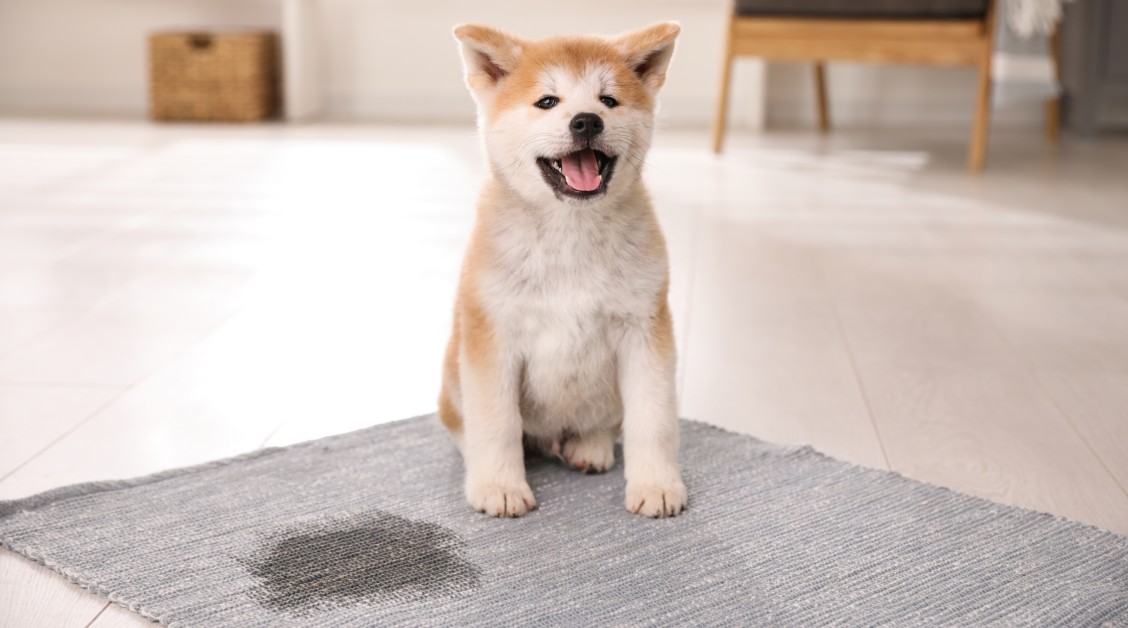A Guide to Potty Training Your Dog
If you've never potty trained a dog before, it's time to learn the basics.

Every dog needs to learn some basic skills, including appropriate elimination behaviors. Just as you once had to learn the right time and place to "go," so must your four-legged friend! Let's examine some basic canine potty training essentials, from how and when to initiate potty training for your dog to the tools you'll need and situations in which your veterinarian may prove helpful.
When to Begin Potty Training Your Dog
Although people commonly think of potty training as puppy training, older dogs may need to learn when and where to go to the bathroom as well. In fact, if your older dog is already trained to use a crate or walk on a leash, you might even find the training process easier than you thought. You can reward your dog with treats when it pees or poops during daily walks, while leaving the animal in a crate for a few hours in your absence shouldn't be a concern.
Generally, however, you'll want to potty train your dog as early in life as possible, not least because puppies have smaller bladders and digestive systems that make them need to go more frequently than their adult counterparts. Since puppies eat and drink multiple times a day, feeding them on a regular schedule will encourage correspondingly predictable bathroom intervals.
When to Plan Potty Breaks
If your puppy is less than three months old, take it outdoors every couple of hours so it can relieve its baby-sized bladder and bowels without soiling your home. Your puppy will learn to associate the need to go with the need to venture outside. It can then communicate that need to you through whining, scratching at the door, and other obvious signals.
As your puppy grows into maturity, you'll find that it can wait longer and longer before taking a bathroom break. As a general formula, add one hour for each additional month of your pet's life. For instance, a two-month-old puppy will probably need to go every two hours, while a six-month-old puppy can hold it for six hours.
Dog Potty Training Tools
When you're ready to potty train your dog, start by purchasing some necessary equipment -- including a crate. Crate training is immensely helpful for whenever you need to take your dog to the vet or on a vacation trip. But because dogs also prefer to spend time in clean surroundings, your furry friend will naturally want to keep its enclosure from getting dirty and smelly by leaving it when nature calls.
Choose a crate just large enough for your dog and no larger. A larger crate might encourage the animal to just go in a designated corner, as opposed to asking permission to leave the crate and go outdoors.
Puppy pads can be useful in potty training your dog. These pads absorb urine and keep underlying surfaces mess-free during those occasional, inevitable accidents. You can even train your dog to use a puppy pad in a designated "bathroom zone" in your home if desired. This approach can make good sense if your dog simply can't go outdoors for whatever reason, or if incontinence makes a rush for the door unrealistic.
As a part of the dog potty training process, you can use puppy pads as a transitional strategy from indoor toileting to outdoor toileting. Once your dog learns to use the puppy pad, simply move it to the back porch or backyard and make sure your dog is aware of the relocation. It should then make a beeline for the outdoors whenever it's time for it to go.
Rewards as Positive Reinforcement
Practically every form of dog training can and should include the use of treats as rewards for correct behavior. When your dog pees or poops in the right spot, praise it and feed it a treat so it will continue to do the right thing. You can also hand your pet its favorite toy or give it some extra affection. Whatever reward you give, make sure to give it immediately after your dog does its business to link the good behavior strongly to the reward.
You may have heard stories about owners shoving their pooch’s nose into poop or otherwise punishing their pets when they go inappropriately. Never use punishment to potty train your dog. In addition to being needlessly cruel, it will do nothing to communicate the right message and may only make your dog fearful or even hostile toward you. If your dog has an accident, simply clean up the mess and pretend it never happened.
Serious Elimination Issues? Talk to a Vet
Medical or behavioral problems can interfere with your dog's ability to obey its potty routine. Diabetes, anxiety disorders, urinary tract infections, digestive troubles, and age-related immobility can all prevent your dog from obeying its normal toilet routine. If your dog routinely goes in the same spot in your home, make sure you've cleaned and deodorized that spot thoroughly. Any lingering odor may make your dog think that the spot is an approved bathroom site.
If you're worried about your pet's potty habits, schedule a wellness exam with your veterinarian. This specialist can treat any issues that might cause inappropriate elimination while also offering additional canine potty training and behavior management tips.
Ready to start saving money on pet wellness care?
Then take a look at Mint Wellness, the pet wellness plan that provides fast reimbursement on routine pet care. Save on vaccinations, wellness exams, preventatives, dental, and more!
Learn More


